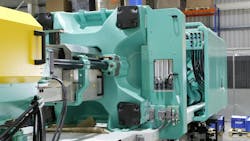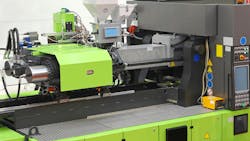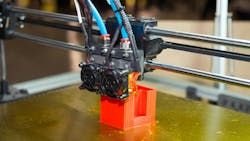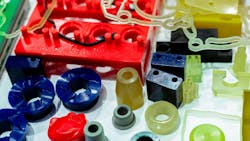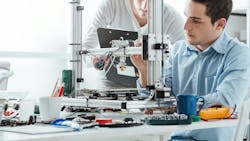Closing the Loop: Real-Time Motion Feedback Improves Prototyping and Injection Molding
What you'll learn:
- How real-time motion feedback can be used for prototyping and injection molding.
- The benefits real-time motion feedback can provide to the manufacturing process.
- Future capabilities that will be possible through the use of real-time motion feedback.
In modern manufacturing, the demand for faster iteration, greater precision, and higher product quality continues to grow. For engineers, designers, and technicians involved in prototyping and injection molding, these goals present both opportunity and complexity.
Real-time motion feedback is emerging as a game-changing solution. By continuously monitoring machine movement, tool position, and material flow, this technology enables closed-loop manufacturing which drives significant improvements in performance, quality, and process control across every stage of development.
This article is the second in a two-part series examining the benefits real-time motion feedback can provide to industrial applications and the systems utilized in them, including those comprised of hydraulic, pneumatic and electromechanical motion control technologies. Read the first article "Closing the Loop: How Real-Time Motion Feedback is Reshaping Industrial Automation" to learn more about what real-time motion feedback entails and the performance improvements it can bring to automated industrial machinery.
The Ongoing Challenges in Prototyping and Injection Molding
Despite advances in digital design and automated manufacturing, prototyping and injection molding still carry inherent challenges.
In prototyping, creating accurate and functional parts often requires multiple iterations to fine-tune geometry, fit, and tolerances. Each new prototype consumes time, materials, and machine hours — slowing down product development timelines.
Injection molding introduces additional variables. Thermal fluctuations, resin inconsistencies, minor tool misalignments, and mechanical wear can all result in dimensional inaccuracies, surface imperfections, or incomplete parts. Warping, shrinkage, sink marks, and flashing remain persistent concerns. Often, these issues only become evident after defective parts have been produced, forcing costly rework or discarded inventory.
The traditional reliance on post-process inspection to detect these problems has limited manufacturers' ability to address them proactively. Correcting defects after they occur not only drives up costs but also delays product launches.
Closing the Feedback Loop with Real-Time Motion Data
Real-time motion feedback addresses the pain points associated with injection molding and prototyping head on. By capturing live data on how machines and tools behave during each cycle, engineers gain unprecedented visibility into every stage of production.
Sensors embedded within the molding machine and tooling monitor parameters such as:
- injection velocity and pressure
- clamping force and platen movement
- tool positioning accuracy
- mold cavity pressure and temperature
- ejection force and part release timing.
This continuous stream of data feeds into control algorithms that instantly detect deviations from optimal conditions. If a tool shifts slightly out of alignment or material viscosity changes during a cycle, the system can automatically adjust injection speed and hold pressure or cooling time to maintain process stability.
These real-time corrections effectively close the loop between machine behavior and part quality, preventing problems before they become defects.
Prototyping: Faster Design Validation and Iteration via Real-Time Feedback
In prototyping, real-time feedback drastically reduces the time required for design validation. Instead of waiting for inspection reports after each build, engineers can monitor dimensional accuracy and mechanical performance during production.
When out-of-tolerance conditions arise, immediate adjustments can be made, sometimes while the part is still being printed or molded. This allows multiple iterations to be completed within a single production window. Designers can fine-tune wall thickness, internal features, and complex geometries far more efficiently, enabling faster progression from concept to functional prototype. Iteration cycles shrink from weeks to days, or even hours.
Real-time feedback also supports the growing use of additive manufacturing in hybrid prototyping workflows. For 3D-printed molds used in short-run injection molding, closed-loop monitoring helps ensure dimensional stability and material consistency even with non-traditional tooling materials.
Injection Molding: How Real-Time Motion Feedback Brings a New Level of Quality Control
Injection molding operations benefit tremendously from real-time motion feedback. Traditional molding relies on pre-set parameters established during trial runs. Once production begins, any drift caused by machine wear, temperature shifts, or resin variation may go unnoticed until off-spec parts are discovered during inspection.
With real-time feedback, machine behavior is actively monitored throughout every cycle. If a clamp force decreases slightly, or a fill rate slows unexpectedly, the system detects and corrects these changes automatically — often before any noticeable part defect occurs.
This leads to:
- Tighter dimensional consistency across entire production runs.
- Lower scrap rates and reduced material waste.
- Faster setup times with fewer trial adjustments.
- Less reliance on operator experience for consistent output.
Instead of reactive troubleshooting, technicians can focus on fine-tuning processes and preventive maintenance while the system maintains stability.
The Critical Role of Material Flow Monitoring in Prototyping and Injection Molding
Material flow remains one of the most challenging variables to control in injection molding. Differences in resin viscosity, temperature distribution, and gate balancing can lead to internal stresses, voids, or uneven part filling.
Real-time cavity pressure sensors provide immediate insights into how resin is flowing during each injection cycle. These sensors allow molders to:
- optimize gate pressures for uniform filling
- balance multi-cavity tools in real time
- detect early signs of material degradation or shear heating
- adjust cooling profiles to control shrinkage and warpage.
Rather than relying on post-mold dimensional checks, engineers can stabilize the entire injection process at its source, within the mold itself.
Empowering Engineers, Designers, and Technicians Through Real-Time Feedback
Real-time motion feedback delivers several distinct benefits for manufacturing teams:
- Accelerated prototyping: Faster, more accurate design validation cycles.
- Improved first-pass yield: More parts meet specifications on the first attempt.
- Reduced scrap and waste: Defects are prevented rather than corrected.
- Process transparency: Root causes of variability are quickly identified.
- Predictive maintenance: Machine wear is detected before it impacts part quality.
By providing data-driven insights at every stage of production, this technology empowers teams to achieve tighter tolerances, shorten timelines, and reduce manufacturing risk.
Future Implications for Plastic Molding
The application of real-time motion feedback in plastic molding is opening new possibilities for process optimization and part design. As closed-loop systems mature, many manufacturers are moving toward fully automated production cells where machines continuously self-correct with minimal human intervention.
Predictive analytics, powered by the rich data generated from motion feedback, allows companies to schedule proactive maintenance, extending equipment life and minimizing unexpected downtime. In highly customized production environments, this level of control enables rapid tool changeovers while preserving quality consistency across diverse product lines.
Ultimately, real-time feedback is transforming plastic molding into a highly adaptive process, capable of producing complex, high-precision parts with far less trial-and-error effort.
Real-time motion feedback represents a fundamental shift in how engineers, designers, and technicians approach both prototyping and injection molding. By closing the loop between machine movement, material behavior, and process control, manufacturers can achieve unprecedented levels of precision, efficiency, and reliability.
As industries demand increasingly complex components with tighter tolerances and faster delivery, this technology offers the control and confidence required to meet those challenges.
This article was written and contributed by Matt Davis, Project Manager at RevPart.
About the Author
Matt Davis
Project Manager at RevPart
Matt Davis is a Project Manager at RevPart, rapid prototyping and manufacturing services provider. With more than 10 years of experience, Davis focuses on product design and the manufacturing process.

Leaders relevant to this article:
